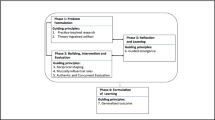Abstract
We investigate the use and knowledge of graphs in the context of a large industrial factory. We are particularly interested in the question of “transparency”, a question that has been extensively considered in the general literature on tool use and, more recently, by Michael Roth and his colleagues in the context of scientific work. Roth uses the notion of transparency to characterise instances of graph use by highly educated scientists in cases where the context was familiar: the scientists were able to read the situation “through” the graph. This paper explores the limits of the validity of the transparency metaphor. We present two vignettes of actual graph use by a factory worker, and contrast his actions and knowledge with that of a highly qualified process engineer working on the same production line. We note that in neither case the graphs were transparent. We argue that a fuller account that describes a spectrum of transparency is needed, and we seek to achieve this by adopting some elements of a semiotic approach that enhance a strictly activity-theoretical view.
Similar content being viewed by others
References
Bakhurst, D. (1996). Social memory in Soviet thought. In H. Daniels (Ed.), An introduction to Vygotsky (pp. 196–218). London: Routledge.
Bakker, A., & Hoffmann, M. (2005). Diagrammatic reasoning as the basis for developing concepts: A semiotic analysis of students’ learning about statistical distribution. Educational Studies in Mathematics, 60, 333–358.
Bakker, A., Hoyles, C., Kent, P., & Noss, R. (2006). Improving work processes by making the invisible visible. Journal of Education and Work, 19, 343–361.
Bowker, G. C., & Star, S. L. (1999). Sorting things out. Classification and its consequences. Cambridge, MA: MIT Press.
Engeström, Y. (2001). Expansive learning at work: Toward an activity theoretical reconceptualization. Journal of Education and Work, 14, 133–156.
Kent, P., Noss, R., Guile, D., Hoyles, C., & Bakker, A. (in press). Characterising the use of mathematical knowledge in boundary crossing situations at work. Mind, Culture, and Activity.
Meira, L. (1998). Making sense of instructional devices: The emergence of transparency in mathematical activity. Journal for Research in Mathematics Education, 29, 121–142.
Nathan, M., Carpenter, G., & Roberts, S. (2003). Getting by, not getting on: Technology in UK workplaces (Report by The Work Foundation iSociety Project). London: The Work Foundation.
Noss, R., & Hoyles, C. (1996a). The visibility of meanings: Modelling the mathematics of banking. International Journal of Computers for Mathematical Learning, 1, 3–31.
Noss, R., & Hoyles, C. (1996b). Windows on mathematical meanings: Learning cultures and computers. Dordrecht, The Netherlands: Kluwer.
Noss, R., Pozzi, S., & Hoyles, C. (1999). Touching epistemologies: Meanings of average and variation in nursing practice. Educational Studies in Mathematics, 40, 25–51.
Peirce, C. S. (1976). In C. Eisele (Ed.), The new elements of mathematics (Vols. I–IV). The Hague–Paris/Atlantic Highlands, NJ: Mouton/Humanities Press.
Peirce, C. S. (1992). The essential Peirce. Selected philosophical writings (Vol. 1, 1867–1893). Bloomington: Indiana University Press.
Roth, W.-M. (2003a). Competent workplace mathematics: How signs become transparent in use. International Journal of Computers for Mathematical Learning, 8, 161–189.
Roth, W.-M. (2003b). Toward an anthropology of graphing: Semiotic and activity-theoretic perspectives. Dordrecht, The Netherlands: Kluwer.
Roth, W.-M. (2004). Emergence of graphing practices in scientific research, Journal of Cognition and Culture, 4, 595–627.
Roth, W.-M., & Bowen, G. M. (2003). When are graphs worth ten thousand words? An expert-expert study. Cognition and Instruction, 21, 429–473.
Stjernfelt, F. (2000). Diagrams as centerpiece of a Peircean epistemology. Transactions of the Charles S. Peirce Society, 36, 357–384.
Zuboff, S. (1988). In the age of the smart machine: The future of work and power. New York: Basic.
Author information
Authors and Affiliations
Corresponding author
Rights and permissions
About this article
Cite this article
Noss, R., Bakker, A., Hoyles, C. et al. Situating graphs as workplace knowledge. Educ Stud Math 65, 367–384 (2007). https://doi.org/10.1007/s10649-006-9058-9
Received:
Accepted:
Published:
Issue Date:
DOI: https://doi.org/10.1007/s10649-006-9058-9




